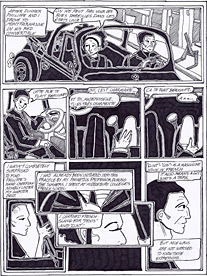Over the years of researching Breathless, I collected and worked with a repertoire of visual material that I could not include in the book. The snapshots and letters, some of which appear here, were crucial to the making of the book. They anchor the story in my mind and also serve as a precious aide-mémoire, which is a lucky thing, given the tricks memories play as we revisit the past.
The Back Story
I left home for Paris in 1961, which was still the 1950s for most middle-class young women in their twenties whose destiny meant marriage, children, and life in the suburbs (two years later Betty Friedan was to publish The Feminine Mystique). Some rebellious girls knew they wanted something else. But what, how to get it, and where? Europe, especially France, above all Paris, was a magnet for young women eager to resist the domestic plot laid out for them. It was, after all, the era of sexy black and white New Wave movies and their stars like smoky and seductive Jeanne Moreau, whose bold sexual adventures contrasted dramatically with the good-girl trials of forever virginal Doris Day.
Like many young women of that decade, I was enamored of everything French—from perfume to slinky black slips and Hermès scarves—and I set out for a year in Paris, after graduating from Barnard College, to live out some great romantic adventure inspired by the movies while taking classes at the Sorbonne. Like the American girl in Godard’s film Breathless played by Jean Seberg, I wanted to take my chances and see what would happen. I would be free. But after a string of embarrassing sexual misadventures, I gave up my short-lived freedom and married an American expatriate, who promised a lifetime of three-star meals and five-star hotels. My husband turned out to be a con man, whose promises were lies, and six years later I had to leave Paris and my dreams behind.
Returning to New York on the threshold of 1968 and its student rebellions felt like another life. It was the time of Vietnam anti-war protests, the shootings of Martin Luther King and Bobby Kennedy, student unrest, sexual liberation, and the first stirrings of second-wave feminism. With more than half of my twenties behind me, I was determined to start over. I knew I had to have a different place: I was a single woman on her own, ready for a new plot. I would no longer try to live through movies, novels, and men. Instead of a consumer, I’d become a professor of literature and the writer of my own life.
My Life as a Graphic Memoir
I love graphic memoirs. I often teach them in my seminars at the Graduate Center (CUNY) since the students love them too—autobiographical, graphic narratives like Marjane Satrapi’s Persepolis or Alison Bechdhel’s Fun Home, both coming-of-age stories. As I was finishing my memoir I found myself wishing I could draw. What would my story, not to mention my life, look like in comic form? After a few attempts on my own, I had to abandon my wishful thinking, but I was reluctant to give up. I was just too curious. I met a wonderful young illustrator, Phoebe Cohen, who was willing to experiment in recreating parts of my story as sequential art (the fancy term for comics). Tahneer Oksman, a graduate student, finishing her dissertation on Jewish women’s graphic memoirs, volunteered to be the developmental editor on the project, helping me to figure out the best way to narrate my adventures in Paris, especially the sentimental ones.
We had hoped that once the memoir was published we would create a visual spin-off, a mini-comic. But graphic narrative is labor intensive and sadly we gave up after finishing the first chapter, “My First French Lover.”
Here are two images from that chapter. I confess that I burst out laughing when I saw what my love life in Paris looked like in Phoebe’s eyes, both the clichés of seduction I fell prey to, and the seductions of Paris itself. Her drawings brought my life back to me, making my memories even more vivid. Frames from this graphic novel-in-progress were used in the book’s trailer.
In the first scene the girl (as I think of the person I was then), newly settled in Paris is driving through a fashionable Left Bank neighborhood with an older French man. Pierre, let’s call him for now, is a friend of her parents, a doctor they met when visiting Paris on a European tour. Pierre is married and fifteen years older than the girl, and he has graciously offered to take his friends’ daughter for a drive at night to show her the sights.
In the second set of panels, Pierre has invited the girl to his apartment and suggested that she spend the night. (His wife is at their country house with his son.) But first he shows her his beautifully decorated bathroom.

